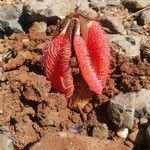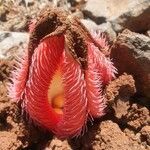A subterranean root parasite. The plant-body rhizome-like, verrucose, up to c. 10 cm wide, ± irregular in shape and somewhat flattened, simple or with widely spreading horizontal branches, firmly-fleshy, brick-red inside, containing mucilage ducts, with sticky exudate when fresh, rich in tannins. Branches ± terete and densely covered with small conical warts. Flowers emerging directly from the 'rhizome' and branches, remaining partially below ground, solitary or several remotely scattered. Perianth fleshy-coriaceous, 5-25 cm long, tube 3-4 cm in diameter, brown and roughly corky outside, pinkish inside. Perianth lobes usually 4, appearing above ground, fully patent in wet weather and lying on the soil surface, otherwise connivent or even connate at the tip, 6-8 cm long, lanceolate, thickly fleshy, broadly channelled and glandular on the inside; the lobe tips (cucullus) ± thickened, triangular in cross-section or grooved outside, the adjacent cucullus faces glabrous and cushion-like; the margins below the lobe-tips broad and beset with subulate setae. Anthers continuously joined at their bases in a series of large inverted 'V's forming a wavy ring, the anther structure transversally striate and divided into very numerous horizontal pollen sacs; pollen sticky, adhering to the anthers. Ovary unilocular, with numerous infolded, pendant placentas. Stigma sessile, cushion-shaped, 3-4(5)-lobed; each lobe finely ribbed and covered with a brown liquid in living material. Fruit entirely subterranean, fleshy, 10-15 cm in diameter, globose, many-seeded, often splitting irregularly at maturity. Outer layer of fruit a scaly periderm; inner pericarp mealy, white, very sweet to taste. Seeds brown, 1-1.77 mm, oblong to globose. Seedlings unknown.
A herb. It grows on other plants. It usually grows on Acacia roots. It grows underground. It is a parasite growing on the roots of Lannea fulva (Engl.) Engl. (Anacardiaceae) and Acacia mellifera. It grows 10-15 cm high. It lacks leaves. It has runner like roots or rhizomes that are thick, hard and dark brown. The flowers are the only part visible above ground. They are brown and scaly and covered with coarse bristles. The flower buds turn rusty red on exposure to the air as they emerge from the ground. The flowers are 15 cm long. They have a bad smell and attract beetles. There are underground stems or rhizomes. The fruit are produced underground. The seeds are embedded in a pulp.
Perianth lobes usually 4, appearing above ground, fully patent in wet weather and lying on the soil surface, otherwise connivent or even connate at the tip, 6–8 cm long, lanceolate, thickly fleshy, broadly channelled and glandular on the inside; the lobe tips (cucullus) ± thickened, triangular in cross-section or grooved outside, the adjacent cucullus faces glabrous and cushion-like; the margins below the lobe-tips broad and beset with subulate setae.
The plant-body rhizome-like, verrucose, up to c. 10 cm wide, ± irregular in shape and somewhat flattened, simple or with widely spreading horizontal branches, firmly-fleshy, brick-red inside, containing mucilage ducts, with sticky exudate when fresh, rich in tannins.
Anthers continuously joined at their bases in a series of large inverted “V”s forming a wavy ring, the anther structure transversally striate and divided into very numerous horizontal pollen sacs; pollen sticky, adhering to the anthers.
Flowers emerging directly from the “rhizome” and branches, remaining partially below ground, solitary or several remotely scattered.
Stigma sessile, cushion-shaped, 3–4(5)-lobed; each lobe finely ribbed and covered with a brown liquid in living material.
Fruit entirely subterranean, fleshy, 10–15 cm in diameter, globose, many-seeded, often splitting irregularly at maturity.
Perianth fleshy-coriaceous, 5–25 cm long, tube 3–4 cm in diameter, brown and roughly corky outside, pinkish inside.
Outer layer of fruit a scaly periderm; inner pericarp mealy, white, very sweet to taste.
Branches ± terete and densely covered with small conical warts.
Ovary unilocular, with numerous infolded, pendant placentas.
Seeds brown, 1–1.77 mm, oblong to globose.
A subterranean root parasite.
Seedlings unknown.



